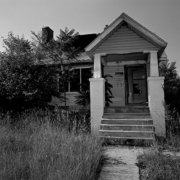Gentrification = Demolition?
by Maggie Flickinger
Here in Denver, as in any built environment, we have a slow churning of development (despite the recent downturn) exemplified by historic neighborhoods passing through the throes of gentrification. Lincoln Park loses historic worker’s housing to make way for ticky tacky, Colfax waves goodbye to a taqueria and hello to a gastropub. The merits and detractions of gentrification (euphemism: revitalization) a varied and often the viewpoint depends on the socioeconomic “status” of those sharing their perspective.
By and large, however, gentrification is a process controlled by the willingness of a neighborhood’s current owners to sell, move, leave, and generally make way for new development. If a block digs in its heels and no “for-sale” signs go up, the neighborhood remains the same. Our municipalities rarely enact eminent domain statutes and when they do, they’re regularly controlled by public process requirements.
Not so in China. A few years ago, stories of large-scale razing of traditional and historic neighborhoods in China surfaced, and pictures such as this depicting a holdout in a neighborhood following eminent domain “reform” laws (circa late 2007, later demolished) popularly illustrated the plight:

More currently, I stumbled on a blog today with a series of incredible rollover images using Google Earth to capture the large scale of this demolition. This was the first I had seen this technique and it was as powerful as it was unsettling. (I’m not tech savvy enough to recreate this here, so just click the images below to be whisked away to the *inspiring* Bricoleurbanism blog)

Before

After
I can’t invite you to “enjoy” images as disturbing as these, but I do appreciate the simple use of free technology to document & publicize compelling global issues! With the advent of “adaptive reuse” in the United States, and preservationist societies emerging world wide, one hopes that not many more images of these ilk will be created.
















The process of gentrification brings both benefits and drawbacks to historic neighborhoods, with perspectives often shaped by socioeconomic status. While it relies on the willingness of current owners to sell and make way for new development, it contrasts with instances of large-scale demolitions in China where eminent domain laws have had a significant impact on traditional and historic neighborhoods.